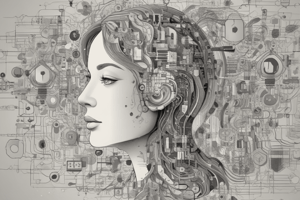Podcast
Questions and Answers
What is a primary advantage of using deep learning over traditional machine learning algorithms?
What is a primary advantage of using deep learning over traditional machine learning algorithms?
- Can manage very simple tasks effectively
- Does not need large datasets
- Requires no preprocessing of data
- Uses multiple layers of neurons for complex pattern recognition (correct)
Which of the following is NOT considered a limitation of deep learning?
Which of the following is NOT considered a limitation of deep learning?
- Difficulty in data preparation
- High computational requirements
- Easily interpretable models (correct)
- Need for large labeled datasets
What preprocessing step is essential for optimal performance of machine learning algorithms?
What preprocessing step is essential for optimal performance of machine learning algorithms?
- Data visualization
- Manual feature extraction
- Redundant data collection
- Feature scaling (correct)
In what context can customer analytics significantly improve business outcomes?
In what context can customer analytics significantly improve business outcomes?
Which frameworks are commonly used for developing deep learning models?
Which frameworks are commonly used for developing deep learning models?
What is a key challenge faced by deep learning technologies?
What is a key challenge faced by deep learning technologies?
Which application is indicative of the impact of AI across various sectors?
Which application is indicative of the impact of AI across various sectors?
Which of the following metrics is commonly used for evaluating machine learning models?
Which of the following metrics is commonly used for evaluating machine learning models?
What does machine learning primarily transform?
What does machine learning primarily transform?
What is a critical step in preparing data for machine learning algorithms?
What is a critical step in preparing data for machine learning algorithms?
Which of the following best describes the role of customer analytics?
Which of the following best describes the role of customer analytics?
What distinguishes deep learning from traditional machine learning?
What distinguishes deep learning from traditional machine learning?
In what area is deep learning NOT commonly applied?
In what area is deep learning NOT commonly applied?
What is involved in model training for machine learning?
What is involved in model training for machine learning?
What is a significant limitation of deep learning?
What is a significant limitation of deep learning?
Which of the following technologies is essential in both machine learning and deep learning?
Which of the following technologies is essential in both machine learning and deep learning?
Flashcards are hidden until you start studying
Study Notes
Data Interpretation by Machines
- Machine learning algorithms transform raw data into knowledge through self-learning techniques.
- Deep learning uses multi-layered neural networks to derive insights from complex datasets.
Preprocessing Data
- Crucial for refining raw data into a usable format for machine learning processes.
- Steps involve scaling features, dimensionality reduction, and splitting datasets into training and testing subsets.
Model Training and Selection
- Process of fitting various algorithms to the data to identify the most effective model.
- Evaluation metrics include classification accuracy and cross-validation techniques to ensure model robustness.
Customer Analytics
- Leverages customer data to enhance business decisions through segmentation.
- Helps tailor products and marketing strategies to specific customer groups, boosting profitability.
Deep Learning
- Automates complex tasks like image and speech recognition using advanced neural networks.
- Requires large labeled datasets and significant computational resources for effective operation.
Applications of AI
- Utilized in diverse sectors including autonomous vehicles, healthcare diagnostics, and financial forecasting.
- Demonstrates the wide-ranging impact of AI technology across various industries.
Deep Learning Techniques
- Employs multiple neuron layers to capture data representations, resulting in improved task accuracy.
- Particularly effective in areas such as image classification and voice recognition.
Challenges in Deep Learning
- Faces obstacles such as the need for extensive labeled datasets and difficulty in interpreting complex models.
- High computational demands can limit the feasibility of widespread application.
Technological Tools
- Key frameworks like TensorFlow and PyTorch facilitate the development and deployment of machine learning and deep learning models.
- These tools provide robust support for building effective AI solutions.
Future Trends in AI
- Ongoing advancements in AI, machine learning, and deep learning are set to drive innovation.
- The evolution of these technologies aims to enhance accessibility and effectiveness in solving real-world challenges.
Studying That Suits You
Use AI to generate personalized quizzes and flashcards to suit your learning preferences.




